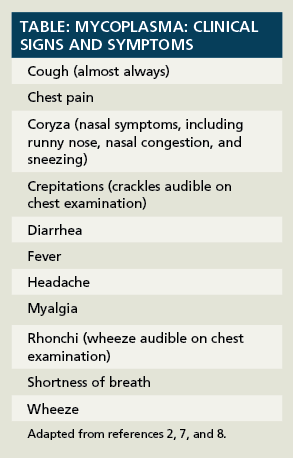Publication
Article
Pharmacy Times
Lingering Cough: Is It Mycoplasma?
Author(s):
When a patient has a lingering cough, the pharmacist should consider mycoplasma infection-a growing problem that can cause a multitude of concerns.
When a patient has a lingering cough, the pharmacist should consider mycoplasma infection—a growing problem that can cause a multitude of concerns.
Coughs that linger after a cold or sinus problem cause constant disruption in the home, school, and workplace. Often, these dry, nonproductive coughs become increasingly troublesome although other symptoms—fever, congestion, and fatigue—resolved days or weeks ago. The cough may produce more sputum as time passes. It prompts friends and relatives to say, “That’s quite a cough you’ve got there!” More often than not, the person ends his prolonged paroxysmal cough and says, “Well, it’s just a cough.” This stubborn cough persists for weeks, and plagues its victim and the victim’s family night and day. The diagnosis might be a common but overlooked cause of lingering cough: atypical pneumonia caused by mycoplasma.
Mycoplasma—pleomorphic bacteria that lack a cell wall—are the smallest and simplest self-replicating organisms known to humans. They probably evolved from gram-positive, walled eubacteria by degenerative evolution. Smaller than amoebas, these 0.1-micrometer organisms grow and reproduce slowly and need no oxygen or host cell. They also change shapes asymmetrically, appearing as long, thin filaments, tiny spheres, or branches. Scientists have identified more than 100 mycoplasma species. Fifteen species are known to live in humans, most as normal symbiotic flora. Mycoplasma pneumoniae, previously called “walking pneumonia,” is pathogenic in humans.1
M pneumoniae glides freely and uses its specialized filamentous tips to burrow between cilia within the respiratory epithelium, causing the respiratory epithelial cells to slough. It also produces hydrogen peroxide, which causes initial cell disruption in the respiratory tract and damages erythrocyte membranes.1
A Puzzling Picture
Traditionally, M pneumoniae was difficult to culture in the lab and was considered to be rare. With today’s more sensitive antibody tests, mycoplasma infection is easier to detect and is now known to be a common infection.2 Laboratory testing usually employs tests for IgG, IgA, and IgM antibody levels in the blood to identify mycoplasma infection. IgM and IgA antibodies disappear after months to years, so their presence indicates recent mycoplasma infection. Two blood tests taken 5 days to 2 weeks apart will show notable increases in antibody levels if infection is present. IgG antibodies form at the beginning of the infection, peak at about 1 month, and then decline slowly but persist throughout life. Positive IgG results only indicate that an individual was infected sometime in the past.3 Polymerase chain reaction testing is faster and more sensitive, but still not widely available.4
Researchers have determined that more than 40% of infants younger than 1 year have had a mycoplasma infection. By age 5, approximately 65% of children have been infected and almost all adults have had it at least once and often repeatedly.5 Mycoplasma pneumonia usually affects people younger than 40 years. Its highest incidence is found in the 5- to 9-year age group.6

The risk of contracting mycoplasma pneumonia is greatest for people who live or work in crowded areas, such as daycare facilities, schools, homeless shelters, long-term care, and military and prison environments. Many people who develop mycoplasma infections have no identifiable risk factor, however. Most mycoplasma infections cause mild to moderate clinical symptoms (Table), but the infection incubates over 3 weeks and lasts weeks without treatment. This infection cannot be diagnosed based on symptoms alone; laboratory testing is essential. Infection can also cause ear infections, sinus infections, bronchitis, croup, severe sore throats, infectious asthma, and 1 type of the common cold. When mycoplasma infects children, about 25% of them develop nausea, vomiting, or diarrhea.1
Most people recover very slowly and completely without antibiotics, although antibiotics may speed recovery. Allowed to progress in rare susceptible individuals (the elderly and immune-compromised individuals), mycoplasmas can cause hepatitis, pancreatitis, arthritis, heart disease, anemia, or neurologic disease.1 Epidemics of mycoplasmal pneumonia have been reported every 4 to 8 years in the general population, but occur more often in close populations.1
Treatment: Supportive and Drug
Antibiotics that target cell wall synthesis do not work on mycoplasma for the obvious reason that mycoplasma have no cell wall. The macrolides—erythromycin, azithromycin, and clarithromycin—are used most often to eradicate the infection, and fluroquinolones and tetracyclines also work. In the last several years, macrolide-resistant mycoplasma infection has been identified in several industrialized nations. Doxycycline and minocycline tend to be effective in these cases.9,10
Patients who have fever or headache can take aspirin, nonsteroidal anti-inflammatory drugs, or acetaminophen. Aspirin is not indicated in children due to risk of Reyes Syndrome. Cough suppressants are not indicated. Instead, advise patients to drink plenty of fluids to help loosen secretions and bring up phlegm. If fatigue is a problem, rest is reasonable.11
Conclusion
With the increasing realization that mycoplasma infection is a growing problem and occurs at epidemic levels, pharmacists need to heighten their awareness of this infection. The next time you overhear someone say, “That’s quite a cough you’ve got there!”, think about mycoplasma.
Ms. Wick is a visiting professor at the University of Connecticut School of Pharmacy and a freelance clinical writer.







